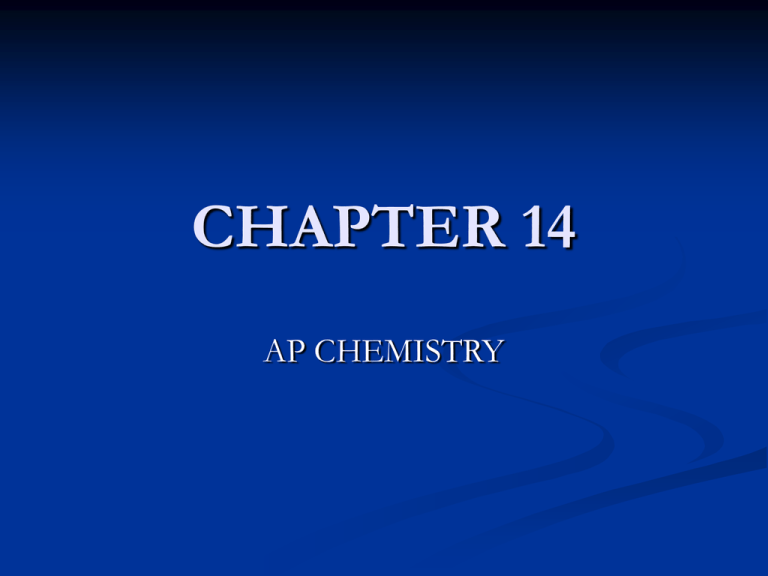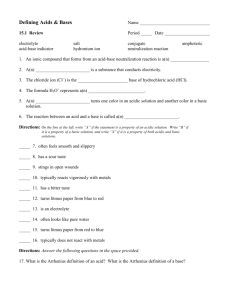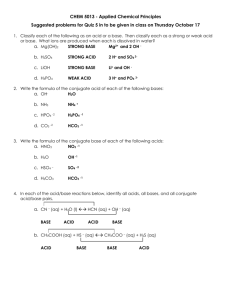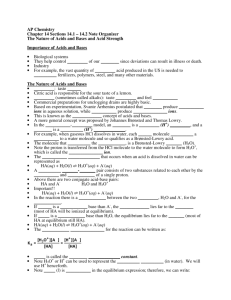CHAPTER 14
advertisement

CHAPTER 14 AP CHEMISTRY NATURE OF ACIDS AND BASES Acids - sour Bases (alkali) - bitter and slippery Brønsted-Lowry Acid is a proton [H+] donor, base is a proton acceptor H+ never found in water, will always form the hydronium ion HA(aq) + H2O(l) --> H3O+(aq) + A-(aq) Acid Base Conj. Acid Conj. Base ka = [H+][A-] [HA] Diprotic acid - forms two protons Page 627 table 14.1 Continue Carboxyl group Page 628 table 14.2 Arrange the following species to strength as a base H2O, F-, CN-, Cl-, NO2- WATER AS AN ACID OR BASE Amphoteric - can be either an acid or base OH- — H2O — H3O+ NH2- — NH3 — NH4+ Any aqueous solution that contains H3O+ ions and OH- ions will eventually reach equilibrium 2 H2O <==> H3O+(aq) + OH-(aq) Continue Any pure solids or liquids do not have concentrations, therefore they are not placed in the equation kw = [ H3O+][OH-] = 1.0 X 10-14 at 25 °C When [ H3O+] = [OH-] = 1.0 X 10-7 a reaction will be neutral [ H3O+] < [OH-] the solution is basic [ H3O+] > [OH-] the solution is acidic Calculate the [H3O+] or [OH-] opposite of what you have and state if the solution is neutral, acidic, or basic 2.0 X 10-5 M H3O+ 3.0 X 10-9 M OH1.0 X 10-7 M OHOrange juice demo pH SCALE pH = -log [H+] Significant figures of the concentration is equal to the number of places after the decimal point. 1.0 X 10-9 two sig. figs. so the pH will have two decimal places pH = 9.00 pOH = -log[OH-] pk = -log k [H+] = 10-pH pH = 7 neutral, pH < 7 acidic, pH > 7 basic STRONG ACIDS HCl, HBr, HI, HNO3, H2SO4, HClO4, HClO3 Look for the major components found in the solution HCl(aq) has H+, Cl-, and H2O Look at what can give H+ H2O <=> H+ + OHHCl ---> H+ + ClWater gives such a small amount of hydrogen ions we can ignore it WEAK ACID HF(aq) species are H+, F-, H2O. Look at those which can give H+ HF(aq) <=> H+ (aq) + F-(aq) ka = 7.2 X 10-4 H2O(aq) <=> H+(aq) + OH-(aq) ka = 1 X 1014 HF is a weak acid but it is stronger than water so it is the dominant source of H+ HX(aq) + H2O(l) <=> H3O+(aq) + X-(aq) Continue Go over example page 639 % dissociation = amount dissociated X 100 Initial concentration Page 641 example STRONG BASES - group 1 metals, calcium, barium, and strontium AMINE GROUPS B(aq) + H2O(l) <=> BH+(aq) + OH-(aq) kb= [BH+][OH-] [B] Page 647 table 14.3 Page 647-650 example ka X kb = kw POLYPROPTIC ACID Can furnish more than one proton H3PO4 <=> H+ + H2PO4- ka = 7.5 X 10-3 H2PO4- <=>H+ + HPO42- ka = 6.2 X 10-8 HPO42- <=> H+ + PO43- ka = 4.8 X 10-13 With each proton lost the ka becomes smaller Page 651 table 14.4 Page 651 example metallic oxides are strong bases O2- + H2O <=> 2OH- ACID-BASE PROPERTIES OF SALT SOLUTIONS Cations Spectators - derived from a strong base Li+, Na+, K+, Ca2+, Sr2+, Ba2+ Acidic - all other cations (transition metals included) Anions Spectators - derived from a strong acid Cl-, Br-, I-, NO3-, ClO4-, SO42Basic - derived from a weak acid F-, NO2-, CO32If the cation is acidic and anion basic, you look at their ka and kb ACID-BASE CHARACTERS Any molecule with a H-X bond can be an acid IF TWO rules are followed In general metal hydrides are basic or have no acid-base properties Nonmetal hydrides are acidic or have no acidbase properties Pages 659-661 examples and tables 14.5, 14.6, 14.7 Read 662-669







